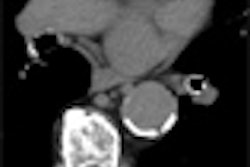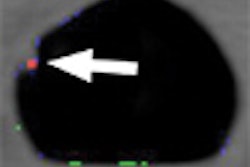Sixty-four slice coronary CT angiography (CTA) forges ahead as the go-to imaging modality in coronary artery disease, but the diagnostic test carries a significant risk for radiation-induced cancer, especially in women and younger patients, according to a study published today in the Journal of the American Medical Association.
In their phantom model study, Dr. Andrew Einstein, Ph.D., and colleagues estimated the age-specific lifetime attributable cancer risk (LAR) based on age, sex, and scan protocol. They found that "rather than a relatively constant risk of cancer in 1 person per 1000 to 2000 exposed, the LAR ranged from less than 0.02% to nearly 1%" (JAMA, July 18, 2007, Vol. 293:3, pp. 317-323).
Einstein is an assistant professor of clinical medicine at Columbia University College of Physicians and Surgeons in New York City. His co-authors are Dr. Milena Henzlova, Ph.D., of Mount Sinai Medical Center in New York City and Dr. Sanjay Rajagopalan at Ohio State University in Columbus.
Standard spiral CT protocols, including electrocardiographically controlled tube current modulation (ECTCM), were performed on standardized male and female anthropomorphic mathematical phantoms coupled with the application of Monte Carlo simulations to estimate statistical distribution of dose. Data was correlated with calculated age- and sex-specific LARs of individual cancers using the framework of the 2006 National Research Council's Biological Effects of Ionizing Radiation VII (BEIR VII Phase 2) report.
Doses from the coronary CTA protocols
 |
|||||
| Organ equivalent doses, mSv* | |||||
| Sex | ECTCM | Aorta | Effective dose, mSv** |
Breast | Lung |
 |
|||||
| Female | No | No | 21 | 77 | 74 |
| Male | No | No | 15 | 65 | |
| Female | Yes | Yes | 19 | 52 | 59 |
| Male | Yes | Yes | 15 | 58 | |
 |
|||||
| *Organ equivalent doses reported here only for organs with a dose > 10 mSv for standard male or female patient; the doses are displayed here as integers, although more significant figures were retained for calculations. **Effective dose determined using International Commissionon on Radiological Protection Publication 60 tissue weighting factors. |
|||||
| Adapted from Table 1, Einstein A, Henzlova M, and Rajagopalan S, "Estimating Risk of Cancer Associated With Radiation Exposure From 64-Slice Computed Tomography Coronary Angiography," Journal of the American Medical Association, July 18, 2007, Vol. 298:3: 317-323. | |||||
They found that organ doses ranged from 42-91 mSv for the lungs and 50-80 mSv for the female breast. The lifetime cancer risk estimates for standard cardiac scans came in at 1 in 143 for a 20-year-old woman to 1 in 3,261 for an 80-year-old male. Other study results:
- A combined CT scan of the heart and aorta posted higher LARs, up to 1 in 114 for a 20-year-old woman.
- The estimated cancer risk using ECTCM was 1 in 715 for a 60-year-old woman and 1 in 1,911 for a 60-year-old man.
- By using ECTCM, the risk estimate for a 20-year-old female decreased to 1 in 219 and to 1 in 5,017 for a 20-year-old male.
The authors explained that "risks were particularly high for women in their 20s and decreased markedly as a function of age.... The leading cause of cancer in women from a (coronary CTA) scan was breast cancer until 32 years of age, after which lung cancer risk exceeded that of breast cancer." In addition, "estimated risks were considerably lower in men ... and decreased as a function of age."
In an interview with AuntMinnie.com, Einstein said he anticipated three major implications for clinical practice based on the results of this study.
Einstein acknowledged that coronary CTA does provide rapid assessment of a patient who presents with chest pain, but recommended that, in younger women, the value of such a scan should be weighed against potential cancer risk.
It's a different story for older patients, Einstein said. In older patients, "if you're thinking about ordering the test because of some clinical suspicion of coronary disease, the potential benefits of treating the coronary disease far, far outweigh the risks associated with the radiation of the test," he stated.
Finally, these study results should sway clinicians to think carefully about using coronary CTA as a screening tool. "Until we have evidence that screening in this manner improves outcomes for patients -- now knowing there is some cancer risk associated with it -- it is not something I would recommend, without discussing it with a physician first, and then it should only be recommended for a specific reason," Einstein said. He also warned that the additive effects of radiation exposure during multiple scans should be considered.
Efforts by CT vendors to develop low-dose scanning techniques are commendable, Einstein said, adding that in a few years' time, more effective tube current modulation, step-and-shoot scan protocols, breast shielding, and dual detector technology will address radiation concerns.
"It is not going to eliminate the cancer risk entirely, but whatever we can do to reduce that risk is important in advancing the technology of CT angiography," Einstein said.
By Cheryl Hall Harris, R.N.
AuntMinnie.com contributing writer
July 17, 2007
Related Reading
Coronary CTA results correlate with all-cause mortality, June 19, 2007
64-slice CTA upheld as dependable test for ruling out CAD, April 30, 2007
Report: U.S. exposure to medical radiation skyrockets, April 19, 2007
ACR issues white paper on radiation dose, April 19, 2007
Radiation dose slashed in 64-slice coronary CTA, February 15, 2007
Copyright © 2007 AuntMinnie.com




















